Spatiotemporal Patterns of Ground Monitored PM2.5 Concentrations in China in Recent Years
Abstract
:1. Introduction
2. Data and Methodology
2.1. Data and Study Area
2.2. Methodology
2.2.1. Mathematical Model Form
2.2.2. Determination of Prior Distribution
3. Results
3.1. Descriptive Statistics
3.2. Bayesian Statistics Results
3.2.1. The Spatial and Temporal Evolution of the Autumn-Winter Season
3.2.2. The Spatial and Temporal Evolution of the Spring-Summer Season
3.2.3. Trend Analysis
4. Discussion
5. Conclusions
Acknowledgments
Author Contributions
Conflicts of Interest
References
- World Health Organization (WHO). The World Health Report 2002—Reducing Risks, Promoting Healthy Life; World Health Organization: Geneva, Switzerland, 2002. [Google Scholar]
- Vajanapoom, N. Health effects of outdoor air pollution, Committee of the environmental and occupational health assembly of the american thoracic society. Am. J. Respir. Crit. Care Med. 1996, 153, 3–50. [Google Scholar]
- Andersen, Z.J.; Bønnelykke, K.; Hvidberg, M.; Jensen, S.S.; Ketzel, M.; Loft, S.; Sørensen, M.; Tjønneland, A.; Overvad, K.; Raaschou-Nielsen, O. Long-term exposure to air pollution and asthma hospitalisations in older adults: A cohort study. Thorax 2011, 67, 6–11. [Google Scholar] [CrossRef] [PubMed]
- Pope, C.A., 3rd; Burnett, R.T.; Thun, M.J.; Calle, E.E.; Krewski, D.; Ito, K.; Thurston, G.D. Lung cancer, cardiopulmonary mortality, and long-term exposure to fine particulate air pollution. JAMA 2002, 287, 1132–1141. [Google Scholar] [CrossRef] [PubMed]
- Chen, Y.; Ebenstein, A.; Greenstone, M.; Li, H. Evidence on the impact of sustained exposure to air pollution on life expectancy from China’s Huai River policy. Proc. Natl. Acad. Sci. USA 2013, 110, 12936–12941. [Google Scholar] [CrossRef] [PubMed]
- Lim, S.S.; Vos, T.; Flaxman, A.D.; Danaei, G.; Shibuya, K.; Adair-Rohani, H.; Almazroa, M.A.; Amann, M.; Anderson, H.R.; Andrews, K.G. A comparative risk assessment of burden of disease and injury attributable to 67 risk factors and risk factor clusters in 21 regions, 1990–2010: A systematic analysis for the Global Burden of Disease Study 2010. Lancet 2012, 380, 2224–2260. [Google Scholar] [CrossRef]
- Lu, J.; Cao, X. PM2.5 pollution in major cities in China: Pollution status, emission sources and control measures. Fresenius Environ. Bull. 2015, 24, 1338–1349. [Google Scholar]
- Xie, Y.; Dai, H.; Dong, H.; Hanaoka, T.; Masui, T. Economic impacts from PM2.5 pollution-related health effects in China: A provincial-level analysis. Environ. Sci. Technol. 2016, 50, 4836–4843. [Google Scholar] [CrossRef] [PubMed]
- Zhang, Y.L.; Cao, F. Fine particulate matter (PM2.5) in China at a city level. Sci. Rep. 2015, 5, 14884. [Google Scholar] [CrossRef] [PubMed]
- Chen, Z.; Wang, J.N.; Ma, G.X.; Zhang, Y.S.; Chen, Z.; Wang, J.N.; Ma, G.X.; Zhang, Y.S. China tackles the health effects of air pollution. Lancet 2013, 382, 1959–1960. [Google Scholar] [CrossRef]
- Cheng, Z.; Wang, S.; Jiang, J.; Fu, Q.; Chen, C.; Xu, B.; Yu, J.; Fu, X.; Hao, J. Long-term trend of haze pollution and impact of particulate matter in the Yangtze River Delta, China. Environ. Pollut. 2013, 182, 101–110. [Google Scholar] [CrossRef] [PubMed]
- Deng, X.; Tie, X.; Wu, D.; Zhou, X.; Bi, X.; Tan, H.; Li, F.; Jiang, C. Long-term trend of visibility and its characterizations in the Pearl River Delta (PRD) region, China. Atmos. Environ. 2008, 42, 1424–1435. [Google Scholar] [CrossRef]
- Dui, W.; Xueyan, B.; Xuejiao, D.; Fei, L.; Haobo, T.; Guolian, L.; Jian, H. Effect of atmospheric haze on the deterioration of visibility over the Pearl River Delta. Acta Meteorol. Sin. 2007, 21, 215–223. [Google Scholar]
- Xiquan, W.; Mingsheng, S.; Ting, Y. Interdecadal change in frequency of dust-haze episodes in North China Plain. Clim. Environ. Res. 2013, 18, 165–170. [Google Scholar]
- Che, H.; Zhang, X.; Li, Y.; Zhou, Z.; Qu, J.J. Horizontal visibility trends in China 1981–2005. Geophys. Res. Lett. 2007, 34, 497–507. [Google Scholar] [CrossRef]
- Deng, J.; Du, K.; Wang, K.; Yuan, C.S.; Zhao, J. Long-term atmospheric visibility trend in Southeast China, 1973–2010. Atmos. Environ. 2012, 59, 11–21. [Google Scholar] [CrossRef]
- Zhao, P.; Zhang, X.; Xu, X.; Zhao, X. Long-term visibility trends and characteristics in the region of Beijing, Tianjin, and Hebei, China. Atmos. Res. 2011, 101, 711–718. [Google Scholar] [CrossRef]
- CNEM Centre. China National Urban. Air Quality Real-time Publishing Platform. Available online: http://106.37.208.233:20035/ (accessed on 25 October 2017).
- Gang, L.; Fu, J.; Dong, J.; Hu, W.; Dong, D.; Huang, Y.; Zhao, M. Spatio-temporal variation of PM2.5 concentrations and their relationship with geographic and socioeconomic factors in China. Int. J. Environ. Res. Public Health 2014, 11, 173–186. [Google Scholar]
- Peng, J.; Chen, S.; Lü, H.; Liu, Y.; Wu, J. Spatiotemporal patterns of remotely sensed PM2.5 concentration in China from 1999 to 2011. Remote Sens. Environ. 2016, 174, 109–121. [Google Scholar] [CrossRef]
- Van, D.A.; Martin, R.V.; Brauer, M.; Boys, B.L. Use of satellite OBSERVATIONS for long-term exposure assessment of global concentrations of fine particulate matter. Environ. Health Perspect. 2015, 123, 135–143. [Google Scholar]
- Li, J.; Jin, M.; Xu, Z. Spatiotemporal variability of remotely sensed PM2.5 concentrations in china from 1998 to 2014 based on a bayesian hierarchy model. Int. J. Environ. Res. Public Health 2016, 13, 772. [Google Scholar] [CrossRef] [PubMed]
- Lu, D.; Xu, J.; Yang, D.; Zhao, J. Spatio-temporal variation and influence factors of PM2.5 concentrations in China from 1998 to 2014. Atmos. Pollut. Res. 2017, 8, 1151–1159. [Google Scholar] [CrossRef]
- Van, D.A.; Martin, R.V.; Brauer, M.; Hsu, N.C.; Kahn, R.A.; Levy, R.C.; Lyapustin, A.; Sayer, A.M.; Winker, D.M. Global estimates of fine particulate matter using a combined geophysical-statistical method with information from satellites, models, and monitors. Environ. Sci. Technol. 2016, 50, 3762–3772. [Google Scholar]
- Ma, Z.; Hu, X.; Huang, L.; Bi, J.; Liu, Y. Estimating ground-level PM2.5 in China using satellite remote sensing. Environ. Sci. Technol. 2014, 48, 7436–7444. [Google Scholar] [CrossRef] [PubMed]
- Li, G.; Haining, R.; Richardson, S.; Best, N. Space–time variability in burglary risk: A Bayesian spatio-temporal modelling approach. Spat. Stat. 2014, 9, 180–191. [Google Scholar] [CrossRef]
- Tobler, W.R. A computer movie simulating urban growth in the detroit region. Econ. Geogr. 1970, 46, 234–240. [Google Scholar] [CrossRef]
- Besag, J.; York, J.; Mollié, A. Bayesian image restoration, with two applications in spatial statistics. Ann. Inst. Stat. Math. 1991, 43, 1–20. [Google Scholar] [CrossRef]
- Gelman, A. Prior distributions for variance parameters in hierarchical models. Bayesian Anal. 2004, 1, 515–533. [Google Scholar] [CrossRef]
- Lunn, D.J.; Thomas, A.; Best, N.; Spiegelhalter, D. WinBUGS—A Bayesian modelling framework: Concepts, structure, and extensibility. Stat. Comput. 2000, 10, 325–337. [Google Scholar] [CrossRef]
- Stramer, O.; Tweedie, R.L. Langevin-type models II: Self-targeting candidates for MCMC algorithms. Methodol. Comput. Appl. Probab. 1999, 1, 307–328. [Google Scholar] [CrossRef]
- Coburn, T.C. Hierarchical modeling and analysis for spatial data. Math. Geol. 2007, 39, 261–262. [Google Scholar] [CrossRef]
- Gelman, A.; Rubin, D.B. Inference from iterative simulation using multiple sequences. Stat. Sci. 1992, 7, 457–472. [Google Scholar] [CrossRef]
- Li, J. Space-time variation of chinese aging based on bayesian hierarchy spatio-temporal model. Stat. Res. 2016, 33, 89–94. [Google Scholar]
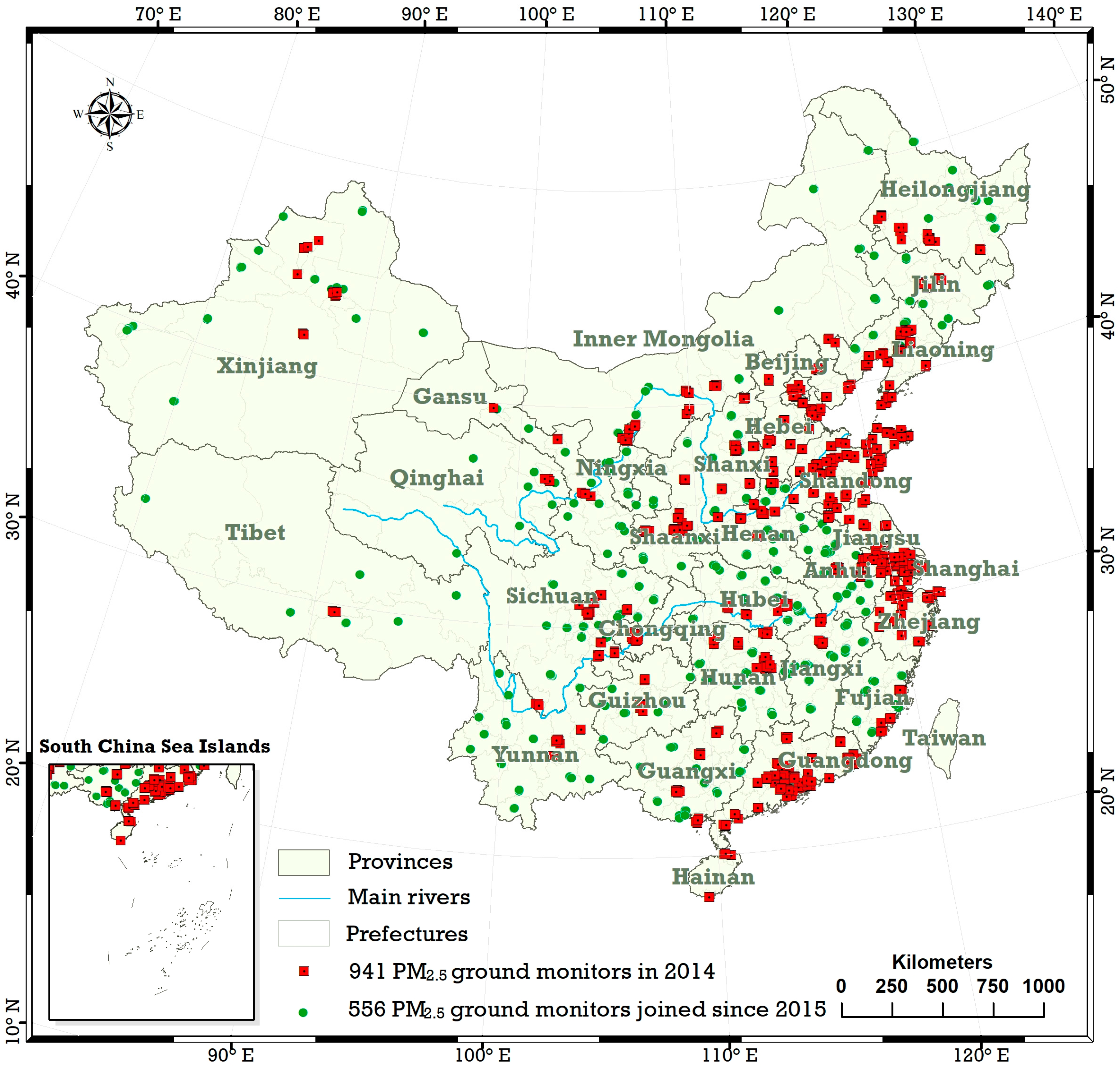
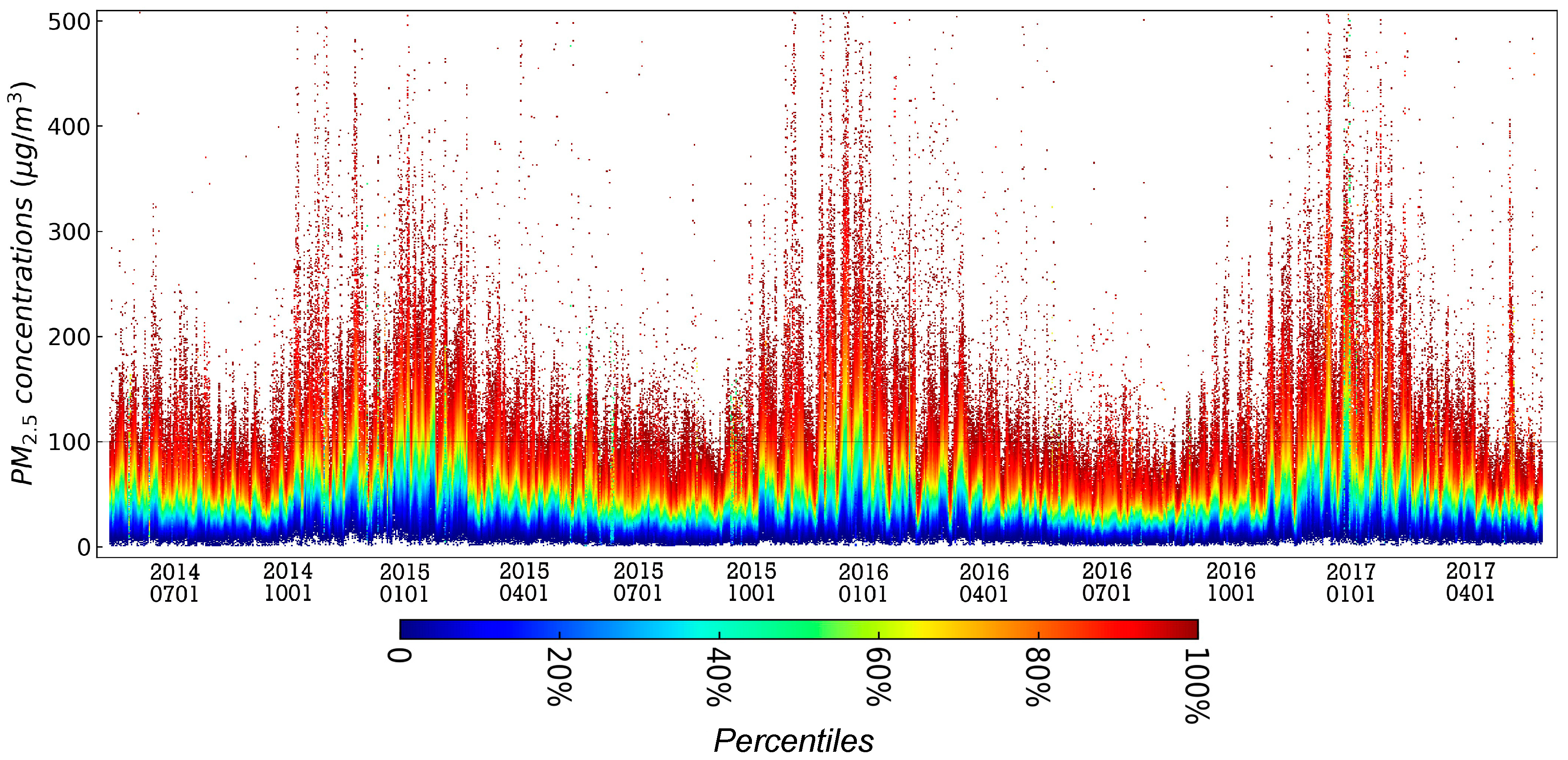

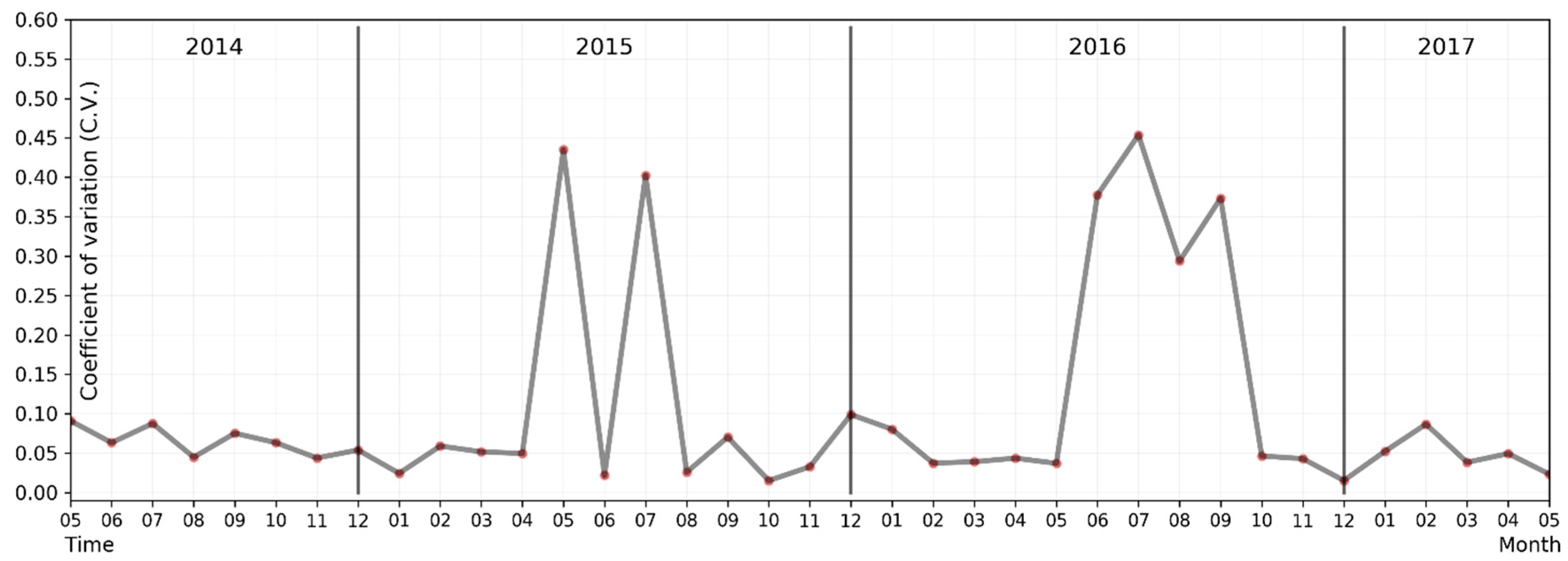
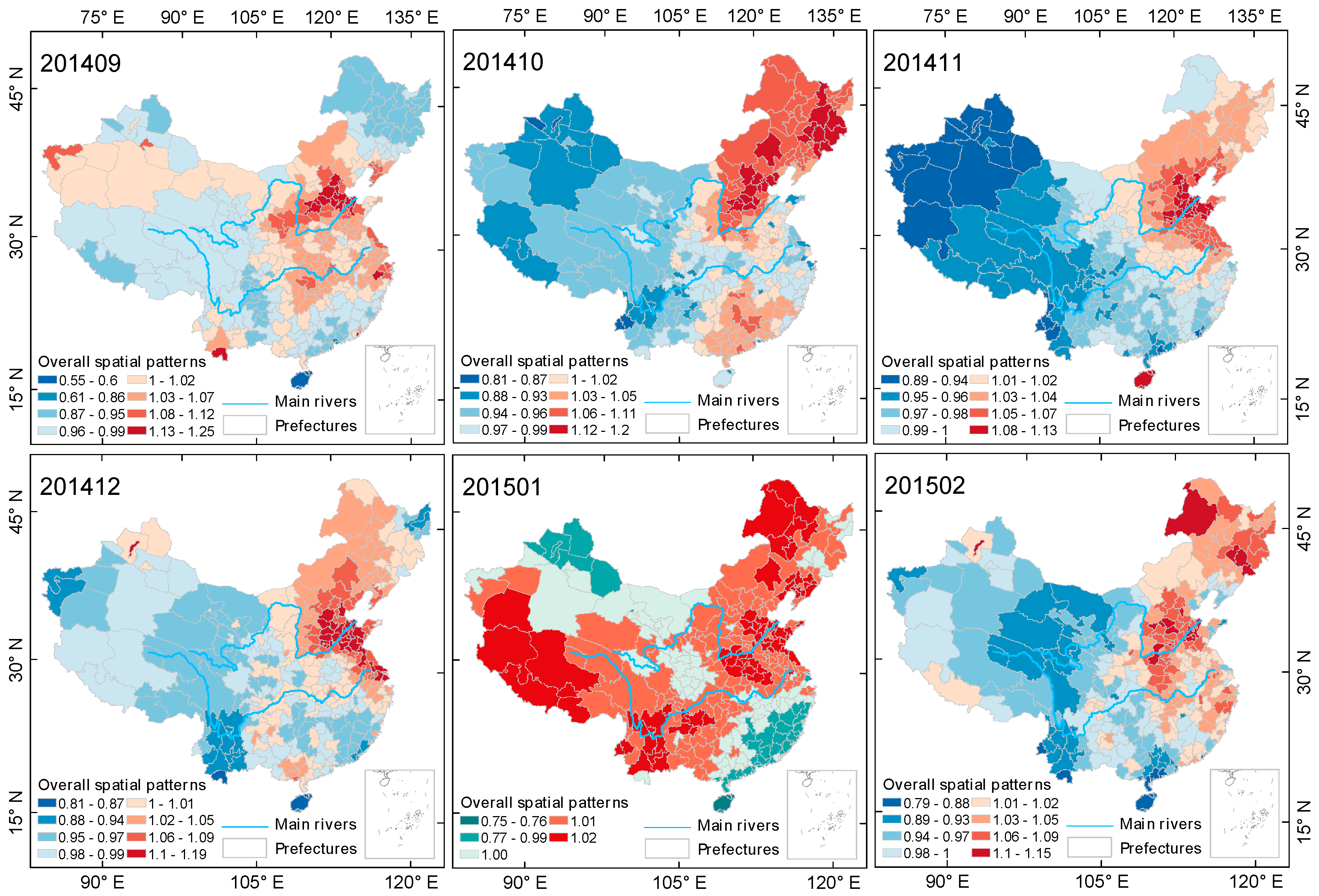
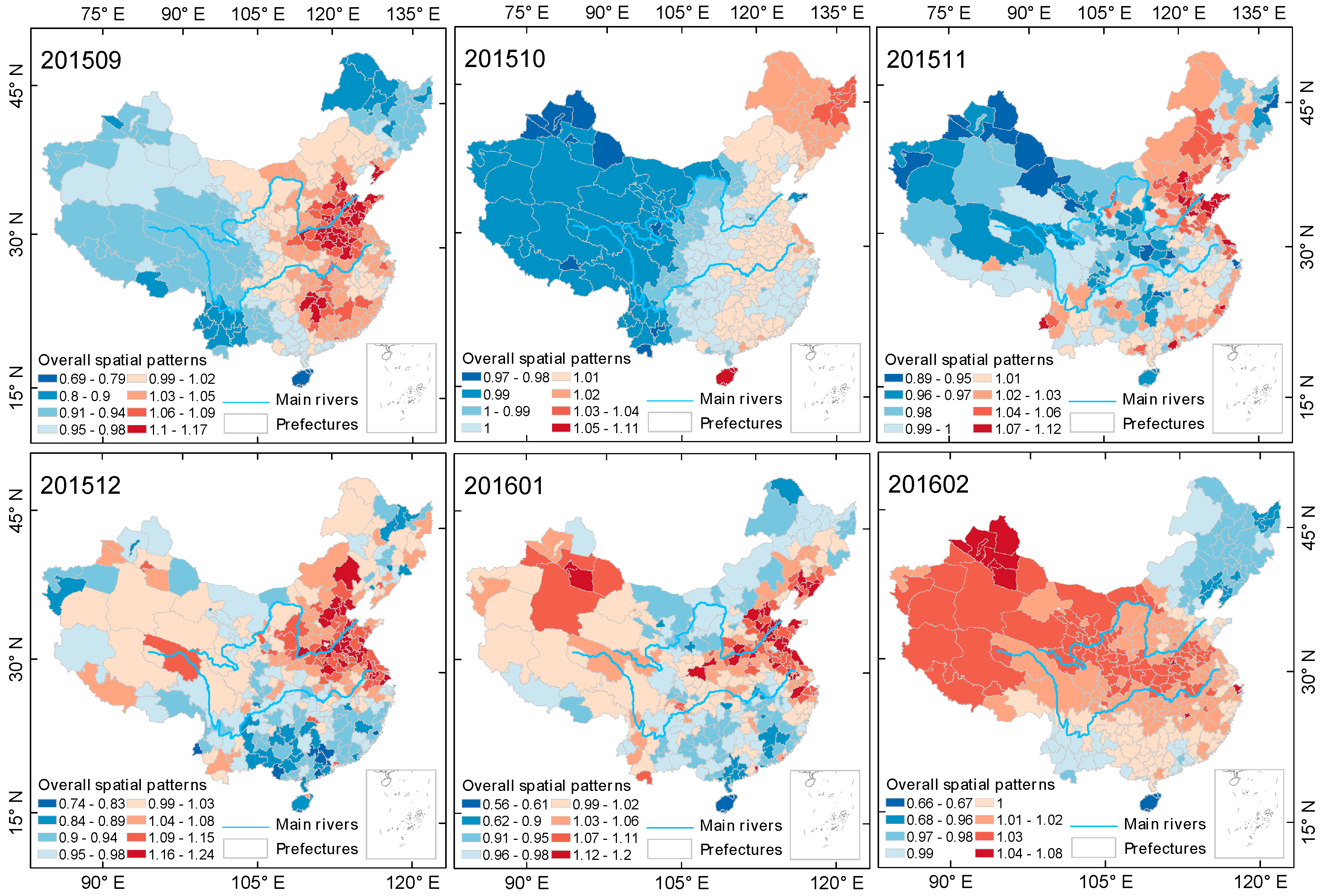

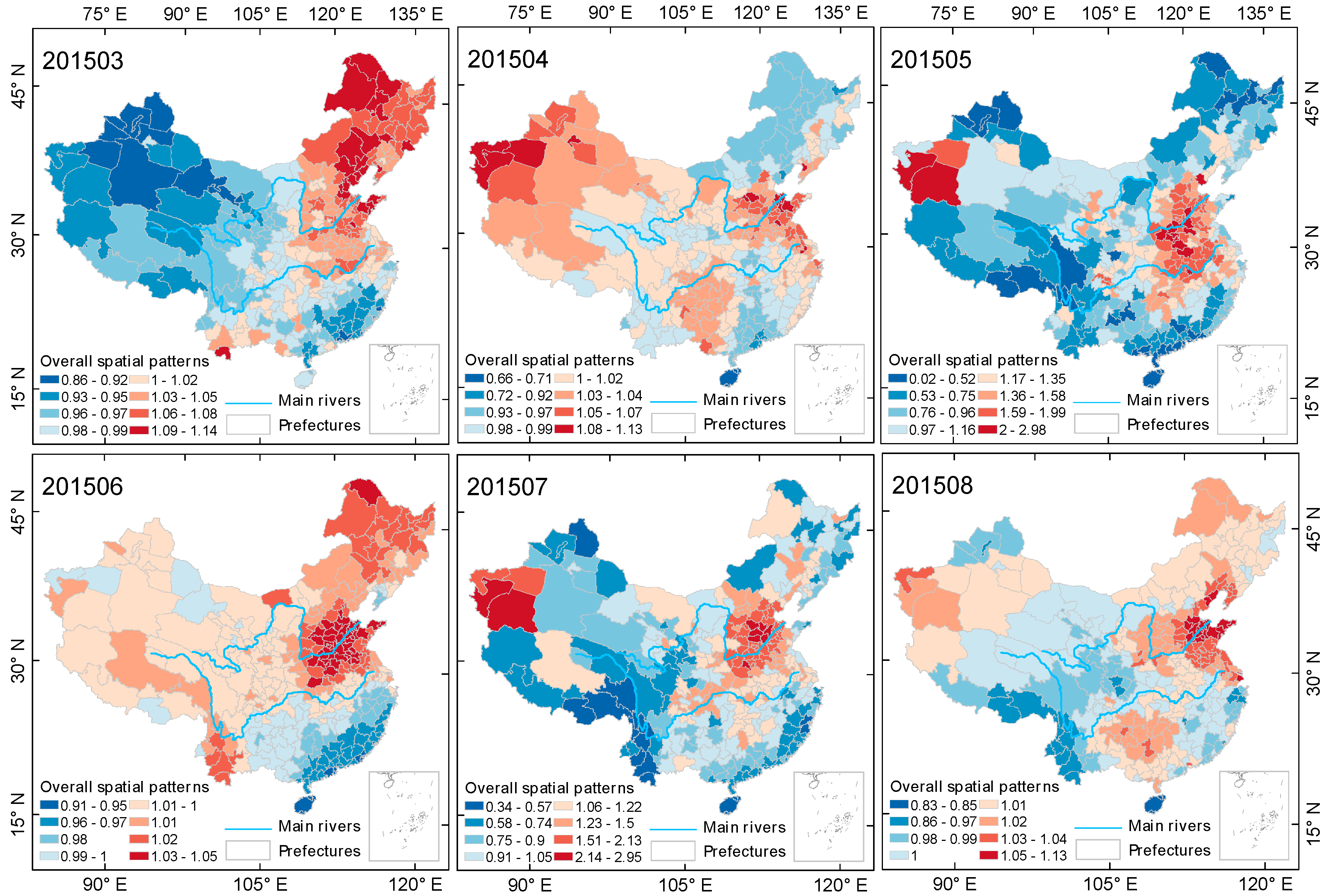
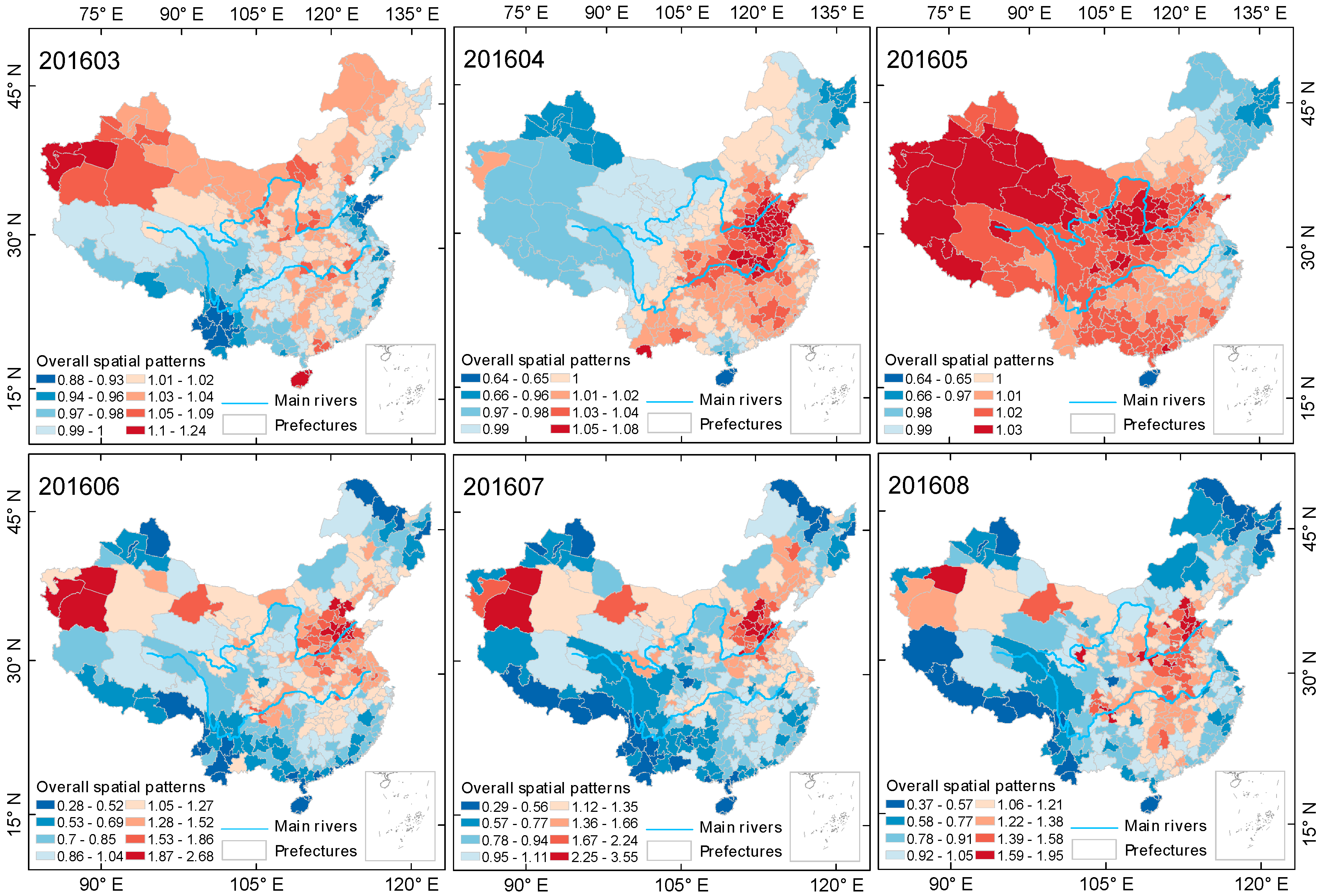

| Province Name | Number of Sites in 2014 | Number of Sites in 2015, 2016, and 2017 | Added Number of Sites |
|---|---|---|---|
| Beijing | 12 | 12 | 0 |
| Tianjin | 14 | 14 | 0 |
| Hebei | 53 | 53 | 0 |
| Shanxi | 32 | 59 | 27 |
| Inner Mongolia | 23 | 44 | 21 |
| Liaoning | 62 | 79 | 17 |
| Jilin | 17 | 33 | 16 |
| Heilongjiang | 27 | 57 | 30 |
| Shanghai | 9 | 9 | 0 |
| Jiangsu | 97 | 97 | 0 |
| Zhejiang | 55 | 55 | 0 |
| Anhui | 19 | 68 | 49 |
| Fujian | 13 | 37 | 24 |
| Jiangxi | 17 | 60 | 43 |
| Shandong | 100 | 100 | 0 |
| Henan | 37 | 75 | 38 |
| Hubei | 18 | 51 | 33 |
| Hunan | 39 | 78 | 39 |
| Guangdong | 102 | 103 | 1 |
| Guangxi | 22 | 50 | 28 |
| Hainan | 7 | 7 | 0 |
| Chongqing | 17 | 17 | 0 |
| Sichuan | 40 | 94 | 54 |
| Guizhou | 15 | 33 | 18 |
| Yunnan | 12 | 40 | 28 |
| Tibet | 6 | 18 | 12 |
| Shaanxi | 37 | 50 | 13 |
| Gansu | 10 | 33 | 23 |
| Qinghai | 4 | 11 | 7 |
| Ningxia | 10 | 19 | 9 |
| Xinjiang | 15 | 41 | 26 |
| Total | 941 | 1497 | 556 |
© 2018 by the authors. Licensee MDPI, Basel, Switzerland. This article is an open access article distributed under the terms and conditions of the Creative Commons Attribution (CC BY) license (http://creativecommons.org/licenses/by/4.0/).
Share and Cite
Li, J.; Han, X.; Li, X.; Yang, J.; Li, X. Spatiotemporal Patterns of Ground Monitored PM2.5 Concentrations in China in Recent Years. Int. J. Environ. Res. Public Health 2018, 15, 114. https://doi.org/10.3390/ijerph15010114
Li J, Han X, Li X, Yang J, Li X. Spatiotemporal Patterns of Ground Monitored PM2.5 Concentrations in China in Recent Years. International Journal of Environmental Research and Public Health. 2018; 15(1):114. https://doi.org/10.3390/ijerph15010114
Chicago/Turabian StyleLi, Junming, Xiulan Han, Xiao Li, Jianping Yang, and Xuejiao Li. 2018. "Spatiotemporal Patterns of Ground Monitored PM2.5 Concentrations in China in Recent Years" International Journal of Environmental Research and Public Health 15, no. 1: 114. https://doi.org/10.3390/ijerph15010114





